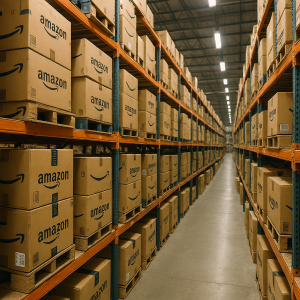Here’s the thing – the opportunities on Amazon haven’t disappeared. They’ve evolved. And many potential entrepreneurs are sitting on the sidelines because of myths and misconceptions that simply aren’t true in 2025.
Today, we’re pulling back the curtain and busting the most persistent myths that might be keeping you from building your Amazon business in no time at all.
The Amazon Landscape in 2025: Quick Facts
Before diving into the myths, let’s ground ourselves with some current Amazon statistics:

- Amazon Prime now boasts over 275 million subscribers globally as of Q1 2025
- The marketplace hosts more than 11 million third-party sellers worldwide, we don’t mind competition
- Third-party sellers account for approximately 62% of Amazon’s total sales volume, and growing annually
- The average successful new Amazon seller can reach $42,000 in monthly sales within 12 months
- E-commerce sales are projected to hit $7.5 trillion in 2025, with Amazon capturing approximately 13% of the entire global market
Now, let’s tackle the most common myths one by one:
Myth #1: “The Amazon gold rush is over – it’s too saturated now.”
We hear this constantly. “Dan and Dylan, you got in early when it was easy!”
Let’s be clear: The landscape has changed, but the opportunity is still massive. In fact, Amazon added over 3,000 new sellers… yesterday. And they’ll add roughly that many today, tomorrow, and the next day.
Why? Because there’s still plenty of room. Amazon’s overall growth continues to outpace seller growth. With Amazon expanding into new markets and product categories continuously, new niches emerge daily. Existing brands are flourishing, and new brands jump on Amazon daily.
In 2025, successful Amazon sellers aren’t competing in the same overcrowded spaces – they’re finding untapped potential in:
- Emerging product categories (sustainable alternatives, smart home innovations)
- Underserved demographics (aging population, Gen Alpha consumers)
- Specialized problem-solving products (not just “me too” items)
The barriers to entry haven’t disappeared – they’ve shifted. Today’s successful sellers need to be more strategic, but the rewards for those who navigate the marketplace intelligently are higher than ever.
Myth #2: “You need a warehouse to sell on Amazon.”

This myth stops countless potential entrepreneurs before they even start.
The truth? Amazon’s Fulfillment by Amazon (FBA) program has evolved to be even more accessible in 2025. Here’s how the process actually works:
- You source products (which can be shipped directly from suppliers)
- Send those products to Amazon’s fulfillment centers
- Amazon stores, packs, and ships your products when they sell nationwide
- They even handle customer service and returns
- You are fully reimbursed for their warehouse damaging goods or in transit damages
Your “warehouse” is Amazon’s sophisticated global fulfillment network. We built our 8-figure business initially by leasing a 1 million square foot warehouse space, but as the FBA program grew to over One Hundred fulfillments centers nationwide we realized this was becoming a relic of the past. Nowadays 100% of our products are shipped regularly without us ever touching them. No leasing a warehouse or storage units, or filling up your garage!
In 2025, Amazon has expanded its fulfillment network with over 185 facilities in the US alone, making the logistics even smoother for sellers.
Myth #3: “You need huge capital to start selling on Amazon.”
This is perhaps the most pervasive myth – and the furthest from the truth.
We launched our Amazon business on a $500 credit card! Today, with Amazon’s Small and Light program and the rise of low-MOQ (Minimum Order Quantity) manufacturers, you can realistically start with as little as $500-$2,000.
Here’s a breakdown of minimum startup costs in 2025:
- Amazon Professional Seller Account: $40/month
- Initial inventory: $500-1,500 (depending on your products)
- Misc costs: $50-500 depending on your state

The key isn’t having massive capital – it’s being strategic about your first product selection. Look for items with:
- Relative competition-to-demand ratio
- Reasonable price points ($15-50 range)
- Small and lightweight characteristics (reduces inbound shipping and FBA fees for more ROI)
- Good margin potential (aim for at least 15% profit margin)
- Boring, stable products make the easiest flip month to month
We’ve mentored sellers who started with a single product and a modest investment, then reinvested profits to grow sustainably.
Myth #4: “You need to be tech-savvy to succeed on Amazon.”
Amazon has invested billions in making their seller platform more user-friendly each year. In 2025, Amazon Seller Central is more intuitive than ever, and Amazon’s Seller University provides step-by-step guidance on every aspect of the business.
Many successful Amazon sellers we know wouldn’t consider themselves “tech people.” The platform is designed for accessibility, not complexity.
Beyond Amazon’s own resources, there’s an enormous ecosystem of user-friendly tools designed specifically for non-technical sellers:
- Listing creation tools with templates
- Inventory management systems with automated reordering
- Simplified keyword research tools
- One-click PPC campaign managers
The technical barriers that existed a decade ago have been systematically removed. If you can use social media or online banking, you have the technical skills needed to manage an Amazon business. Many of the tools we use everyday are free to use with any Amazon seller account.
Myth #5: “It takes months to get your Amazon business running.”
With today’s streamlined processes, you can go from zero to selling in approximately one week. Here’s a realistic timeline for Week 1 depending on your state:

Step 1: Set up Amazon Seller Account and LLC (using formation services, this can be done in 24 hours)
Step 2: Use free software for product research and email via brand’s website
Step 3: Use data on software tools to order your estimated monthly sales and ship to Amazon FBA
Now watch as Amazon makes deposits every other week into your bank account. The bureaucracy and paperwork that once delayed new businesses has been largely digitized and simplified. Services like ZenBusiness or Incfile can form your LLC in 24 hours in most states. Amazon’s seller onboarding has been streamlined significantly since we started.
Myth #6: “You need to master complex advertising strategies.”
Most of our products had healthy sales volume before we jumped on the listing, and we do not run ads at all on them. That being said, Amazon’s advertising platform has evolved to be increasingly user-friendly. The basic Sponsored Products campaigns can be set up in minutes with almost no learning curve.
In 2025, Amazon offers intelligent campaign automation that helps optimize your advertising spend. Their machine learning algorithms continue to improve targeting, bidding, and placement optimization.
While advanced advertising knowledge can certainly improve performance, a simple approach can get you started:
- Set up automatic targeting campaigns with conservative bids
- Let them run for 1-2 weeks to collect data
- Use Amazon’s “Suggested Keywords” report to identify performing search terms
- Create targeted campaigns based on those findings
We’ve seen new sellers achieve advertising cost of sales (ACoS) in the 15-25% range with minimal expertise – more than workable for a profitable Amazon business.
Myth #7: “Success on Amazon is just luck.”
Perhaps the most dangerous myth is that success on Amazon comes down to luck or timing.
After helping hundreds of new sellers launch and scale their Amazon businesses, we can confidently say that success follows patterns and principles. We have it down to a science based on these principles:
- Deep analytics on product research with free software tools
- Quality products direct from brands and their authorized distributors
- Ideal pricing using Seller Central’s base Automatic Pricing features
- Consistent inventory management built into Seller Central to keep reorders consistent
- Proactive problem-solving with our immense online community
In 2025, with more data and tools available than ever before, building a successful Amazon business is more science than art. The outcomes are increasingly predictable when you follow proven processes.
The Real Barriers to Amazon Success
So if these common beliefs are myths, what actually separates successful Amazon sellers from those who struggle?
In our experience, the true barriers are:
- Analysis paralysis: Getting stuck in endless research without taking action
- Perfectionism: Waiting for the “perfect” product instead of launching and learning
- Inconsistency: Treating Amazon as a side hobby rather than a business
- Fear of competition: Being intimidated rather than inspired by successful sellers
Summary: The Amazon Myths, Busted
- Myth: The market is too saturated. Truth: New opportunities emerge daily as Amazon expands.
- Myth: You need a warehouse. Truth: Amazon’s FBA program is your fulfillment solution.
- Myth: You need huge capital. Truth: Start with as little as $500-1,500.
- Myth: You need tech expertise. Truth: Amazon’s platform is designed for all skill levels.
- Myth: You must win the Buy Box. Truth: Sharing the Buy Box is our main moneymaker
- Myth: It takes months to launch. Truth: You can be selling within a week or two tops.
- Myth: Success is just luck. Truth: Success follows formulaic patterns and processes.
Your Path Forward
The e-commerce revolution isn’t over – it’s just getting started. The question isn’t whether opportunities exist, but whether you’ll overcome these myths and seize them. If you’ve been holding back from starting your Amazon journey because of these myths, 2025 might be your year to take action.
Here’s your opportunity to join us on our next free Workshop waiting list. Click below to sign up and you’ll even get our Wholesale 101 Guide to hold you over for now: https://www.thewholesaleformula.com/waitlist/
About the Authors: Dan and Dylan have been selling on Amazon since 2011, building an 8-figure business across multiple brands and categories. They share free content and resources to help new sellers navigate the Amazon marketplace making it better for all sellers. A rising tide favors all boats afterall.

Leave a Reply